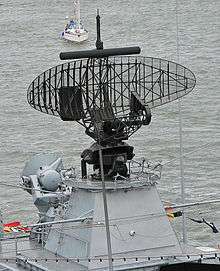Radar lock-on

Lock-on is a feature of many radar systems that allows it to automatically follow a selected target. Lock-on was first designed for the AI Mk. IX radar in the UK, but first used extensively by US ground-based SCR-584 radar. The SCR-584 demonstrated the ability to easily track almost any airborne target, from aircraft to artillery shells.
In the post-WWII era, the term became more widely used in connection to missile guidance concepts. Many modern anti-aircraft missiles use some form of semi-active radar homing, where the missile seeker listens for reflections of the launch platform's main radar. To provide a continual signal, the radar is locked-onto the target, following it throughout the missile's flight.
In older radar systems, through the 1980s, lock-on was normally assisted by a change in the radar signal characteristics, often by increasing the pulse repetition frequency. This led to the introduction of radar warning receivers that would notice this change and provide an audible warning to the operator, typically the pilot. Missile lock-on is typically indicated to the pilot or missile operator via an audible tone, a head-up display or a helmet-mounted display.[1]
Types
Active radar homing
Active radar homing (ARH) is a missile guidance method in which a missile contains a radar transceiver (in contrast to Semi-active radar homing, which uses only a receiver) and the electronics necessary for it to find and track its target autonomously. NATO brevity code for an air-to-air active radar homing missile launch is Fox Three.[2]
Semi-active radar homing
With a semi-active radar homing system, the launch platform acquires the target with its search radar. The missile is then powered up while the launch platform's illuminator radar "lights up" the target for it. The illuminator is a radar transmitter with a narrow, focused beam that may be separate from the search radar and that can be directed at a target using information from the search radar. When the passive radar of the missile's guidance system is able to "see"/detect the radio waves reflected from the target, missile lock-on is achieved and the weapon is ready to be launched.[3]
Passive radiation homing
Many missiles employing passive radiation homing can in effect turn into an anti-radiation missile and home in on the target's radiation passively, as long as the target does attempt to use noise jamming. This makes such missiles practically immune to noise jamming, in addition to removing the second disadvantage. Since they already have the radar receiver on board, this should not be a difficult feature to add (at least, it requires extra processing logic but little extra hardware).
Infrared homing
In this scenario, the target itself provides the (infrared) emissions that the missile's Infrared homing sensor is able to detect; lock-on occurs when the missile is powered up and able to "see" the infrared signature of the target.
Detection by the target
The subject of a radar lock-on may become aware of the fact that it is being actively targeted by virtue of the electro-magnetic emissions of the tracking system, notably the illuminator. This condition will present a heightened threat to the target, as it indicates that a missile may be about to be fired at it.
See also
- Fire-control radar
- Missile guidance
- Air-to-air missile
- Surface-to-air missile
- Radar jamming and deception
- Radar warning receiver
Notes
- ↑ R. P. G. Collinson (2003). Introduction to Avionics Systems. Springer. ISBN 1-4020-7278-3.
- ↑ globalsecurity.org: Brevity: Multi-Service Brevity Codes (retrieved 19 June 2013)
- ↑ Carlo Kopp (June 1982). "Active and Semi-Active Radar Missile Guidance". Australian Aviation.